As the nineteenth century drew to a close, traditional religion and its grand narrative were in general decline — a social reality captured by Friedrich Nietzsche’s famous declaration, “God is dead” (1). While this statement, of course, served Nietzsche’s own philosophical ideals (which in 1882 were still idiosyncratic enough to allow it a serious challenge), one hundred years later and Nietzsche’s prophecy seemed virtually fulfilled. That is, the conception of postmodernity, specifically as put forward by Lyotard, rejected the grand narrative and, by extension, all transcendent narratives and mythic systems (2). The metaphysics upon which God, religion, and other paradigmatic models had rested was deemed discredited and so discarded.
Today, however, as postmodernism gives way to the new ‘structure of feeling’ called metamodernism, the transcendent and archetypal impulse is seeing a resurgence. Myth and grand narratives are receiving a second look and, from a once-homed focus on contingency and context, interests in the ‘timeless’ and ‘universal’ are again finding energetic expression. Has transcendence become viable once more — or has it been reconceived?
In this article I consider the relationship of such a philosophical revaluation to a new and distinctly ‘metamodern’ sensibility. This post-postmodern ethos, eschewing both the naïve metaphysical systems of the past as well as the superficial materialism of postmodernity, has occasioned a project of reconstruction — one in which new myths and paradigmatic models are now being artfully crafted for the twenty-first century.
Immanence and Transcendence: A Useful Hermeneutic
To be clear, the word ‘God’ in this context signifies a conceptual paradigm more expansive than common Western colloquial usage (i.e., ‘a supernatural deity’, typically the Judeo-Christian one). Here I wish to employ the term in its broader sense — one perhaps best elucidated by the traditional philosophical dichotomy immanent/transcendent (3). In this dichotomy the immanent denotes essentially the physical world as such, the domain of empirical phenomena and of our sense perceptions. The transcendent, by contrast, posits a meta-physical reality, which exists beyond or outside of the material world, more fundamental in vantage and essence.
Indeed, envisioned spatially, this image of foundation — of grounding, of basis — serves well. The immanent ‘apparent world’ can be thought of as resting upon transcendent ‘reality’ almost as a superstructure. As such it is secondary, derivative, contingent; it indicates something deeper. So it was that, through the linkage of these two — through relationship of the contingent to the archetypal — purely immanent phenomena were thought to ‘mean’ something or have deeper ‘significance’. Such was ‘God’: as a word, a kind of shorthand for any deeper, transcendent paradigm giving sense and meaning to our immanent, contingent lives.
Postmodernism: Or, the Loss of Depth
The process by which transcendence and grand narratives of faith lost their value or stronghold within contemporary society appears to have begun with modernity and the modern critique of religion. This process culminated within the postmodern worldview, which eschewed not just religious truth but all notions of transcendent truths, all grand narratives, archetypes, and paradigmatic models for living.
In doing so, however, postmodernism saw a radical narrowing of focus — a loss, one might say, of dimensionality. For, without something ‘deeper’, there is only surface: the one-dimensional plane of here and now. Without the grand objective picture there are only countless subjective lenses: no facts, only interpretations (Nietzsche again). In short, the foundation is removed, there is nothing to ground, nothing ‘deeper’ any longer. Now there is only total immanence.
As critics such as Baudrillard have pointed out, this distinctly postmodern development has led to a philosophical preoccupation with surfaces and simulacra—of shallowness and leveling (4). From (pre)modern icons of spiritual transcendence…
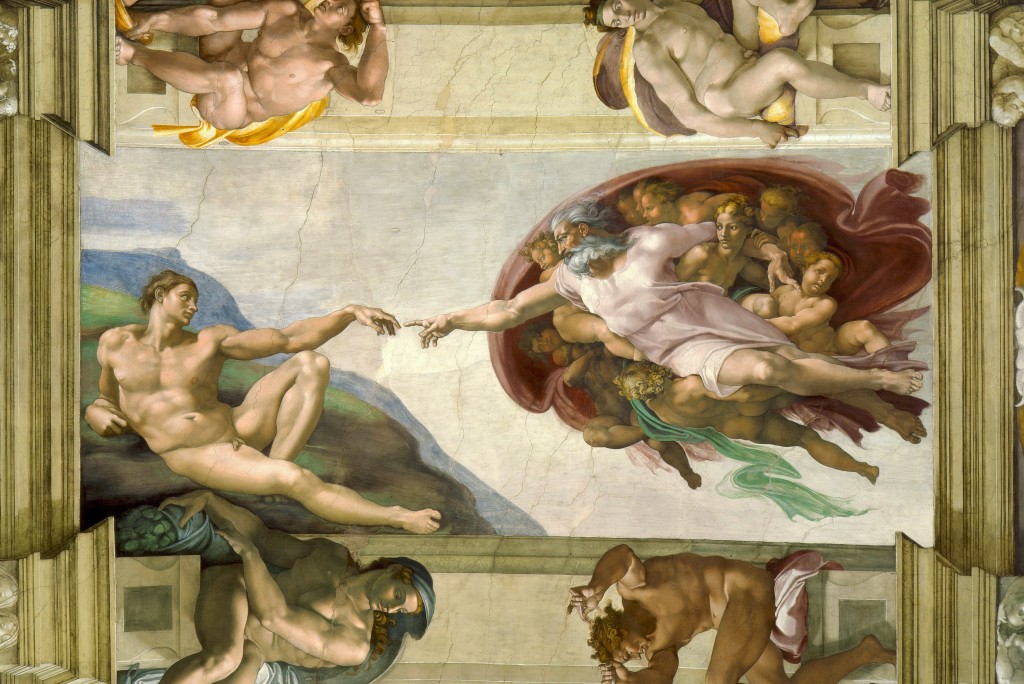
we come to the postmodern kitsch of total material immanence…
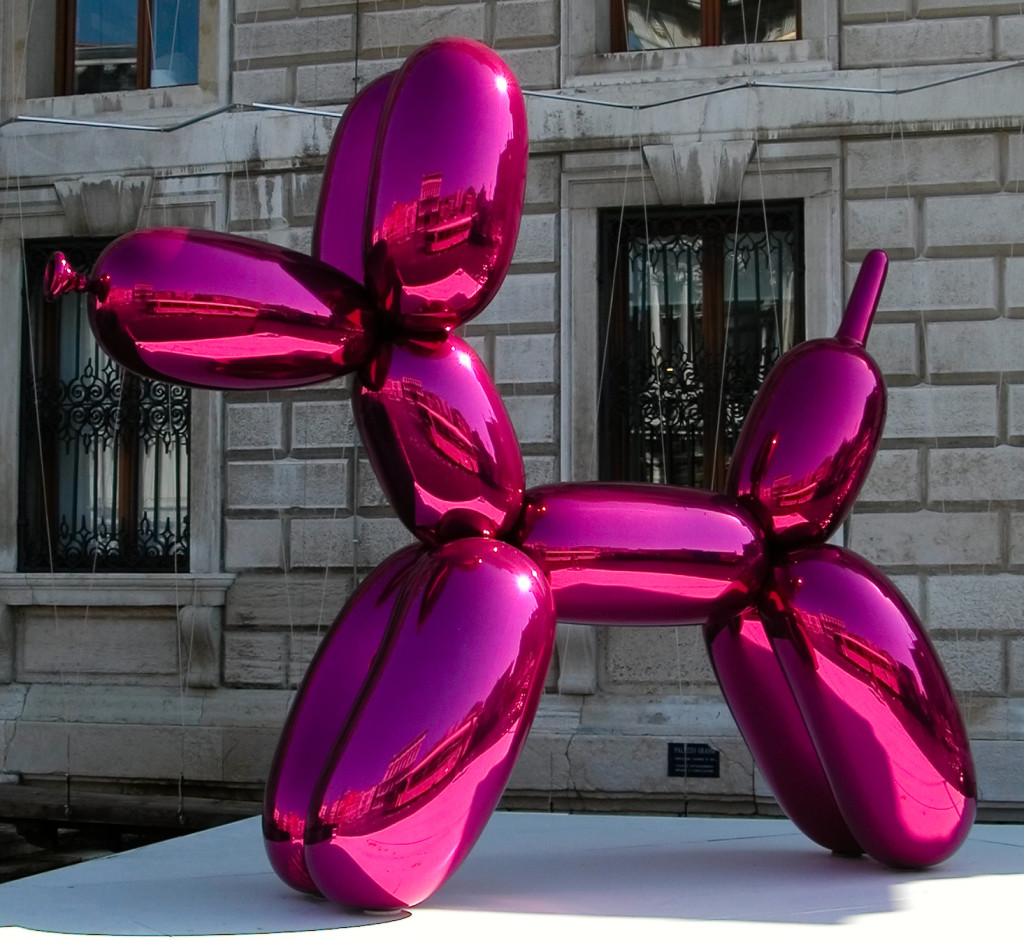
…to signifiers without signifieds, to sensations without Sense, to life without depth.
So, for example, David Harvey’s analysis in The Condition of Postmodernity. Harvey frames his assessment of postmodern thought and culture around Baudelaire’s assertion in “Le Peintre de la vie moderne” that “Modernity is the transient, the fleeting, the contingent; it is the one half of art, the other being the eternal and immutable” (5). Baudelaire here interprets art and its role in modernity precisely in terms of the immanent/transcendent paradigm, associating modernity itself with the former while suggesting that art represents a delicate synthesis of the two. The challenge for the modern artist thus becomes the expression of modernity’s growing immanence through an art still invested with ideals of transcendence. It is precisely here, however, that Harvey locates the postmodern break, arguing that, while modernism grappled in this way with modernization’s heightened sense of the immanent,
postmodernism responds…in a very particular way. It does not try to transcend it, counteract it, or even to define ‘the eternal and immutable’ elements that might lie within it. Postmodernism swims, even wallows, in the fragmentary and the chaotic currents of change as if that is all there is. (6)
Fredric Jameson draws a similar conclusion in his seminal assessment Postmodernism, or, The Cultural Logic of Late Capitalism, seeing in postmodern theory, for example, the total collapse of the “depth model” with its predicated dichotomies of essence vs. appearance, latent vs. manifest, authenticity vs. inauthenticity, and signifier vs. signified. Indeed, the whole “hermeneutic model” is rejected as “depth is replaced by surface” (7). Postmodernity thus seems uniquely preoccupied with immanence, with a world where nothing is ‘out there’, nothing can ‘mean’ anything—and ‘God’, at last, is dead.
Metamodern Mythmaking
With the recent ebb of typically postmodern sensibilities and the rise of a new generation — one reacting not only against a discredited notion of transcendence but also against the unfulfilling shallowness and existential disorientation caused by postmodern surface — we enter a new period: a metamodern period, whose structure of feeling is characterized by a sort of ‘oscillation’ between these poles. Proposed by cultural theorist Timotheus Vermeulen and philosopher Robin van den Akker as the new “dominant cultural logic of modernity”, metamodernism “evokes a continuous oscillation between (i.e. meta-) seemingly modern strategies and ostensibly postmodern tactics, as well as a series of practices and sensibilities ultimately beyond (i.e. meta-) these worn out categories” (8). Indeed, out of this crucible it seems an entirely new kind of depth model has been forged. For some of this generation are daring to imagine transcendence again. There is a revival of the mythic; sublimity, narrative, depth, meaning, and reorientation are once again being sought out and can be seen within metamodern artforms. And yet, precisely because one knows this transcendence cannot be unequivocally asserted (indeed, quite the contrary), its entertainment as an idea is of an essentially different sort than (pre)modern naiveté. It is indeed an “informed naiveté” (9) a sense of transcendence arising out of and ultimately held in check by the acknowledged immanent frame.
This new, qualified transcendence is already informing cultural production. Indeed, when most potently expressed, one sees a kind of metamodern mythopoeia at work — that is, the construction of entirely new paradigmatic models, which, because knowingly created, seem to operate as much as works of art as myth. This metamodern mythopoeia would seem to include both the postmodern condition of doubt and knowingness as well as a more modernist optimism, a naïve faith to create new mythic systems of meaning and thusly induce a sense of greater depth and sublimity. In metamodern mythopoeia, mythologies are invented: liturgies, hymns, ceremonies, scriptures, deities, all as an artist paints a scene. ‘Theology’ becomes a creative and exploratory act, done for the sensation of the thing itself within in the realm of immanence. The most successful metamodern mythopoeia are compelling; indeed, they create an almost convincing sense of transcendence. One even entertains the possibility of being converted to one’s own invented religion…
However, metamodern mythopoeia never decidedly affirms or rejects the idea of the grand narratives of faith and transcendence. Indeed, it is precisely this ambiguity which allows for transcendent experience in the first place: metamodern faith must presume a kind of atheism if one is to have the freedom to create ‘God’. But this fragile theism that metamodern religious conceptions generate never settles on a fixed perspective, never loses the malleability of art. It cannot ossify completely into characteristically naïve religious conceptions before it crumbles again under critical scrutiny back to atheism. Indeed, it is only within this dynamism that such myths can exist.
Reconstruction
In this way metamodern mythopoeia reasserts a form of ‘transcendence’ without forfeiting postmodern immanence as it reconstructs artificial paradigmatic models for the twenty-first century. The result is artistic mythmaking, a feature of metamodernism already observed by Vermeulen and van den Akker, who write that “architects and artists increasingly abandon the aesthetic precepts of deconstruction, parataxis, and pastiche in favor of aesth-ethical notions of reconstruction, myth, and metaxis” (10).
Indeed, more and more young artists today — such as Adam Miller, Martin Wittfooth and Billy Norrby — have begun working with entirely new pictorial mythologies. If contemporary artists such as Jeff Koons or Damien Hirst represented the “postmodern years of plenty [and] pastiche” (to adopt Vermeulen and van den Akker’s words (11)), when the seeming-triumph of late capitalism found expression through “wallowing” in materialist immanence, then these “Post Contemporary” (12) artists are meeting the breakdown of that old system with constructive (re)visions.
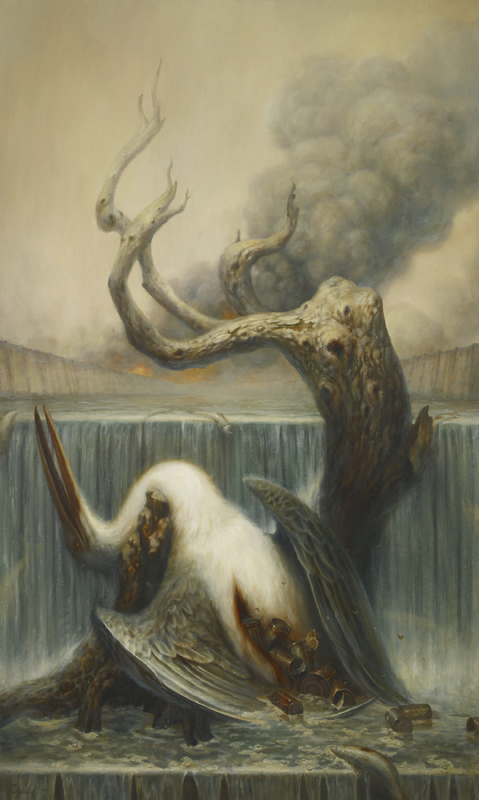
Pieta by Martin Wittfooth, 2011
In their artwork, Wittfooth and Miller for example both employ traditional mythic iconography to frame their critiques of the ecological crisis. Wittfooth’s (2011) work Pieta, taking its name from the Judeo-Christian trope of the Virgin Mary cradling the dead body of Jesus, depicts the carcass of a bird whose stomach spews the pollutants and toxic materials that killed it. Here the tree upon which it is draped assumes the role of Mary, and through this association seems anthropomorphized. A conspicuous hole near its upper limbs acts as the traditional shaming gaze of the Virgin; like her, it stares out from the painting to indict the audience of the crime in its arms. The religious narrative of sin and atonement may have lost its general efficacy, but here it finds a replacement. The sense of the sacred is transferred to Nature — fully immanent, yet suggestive of some new transcendence, and demanding action.
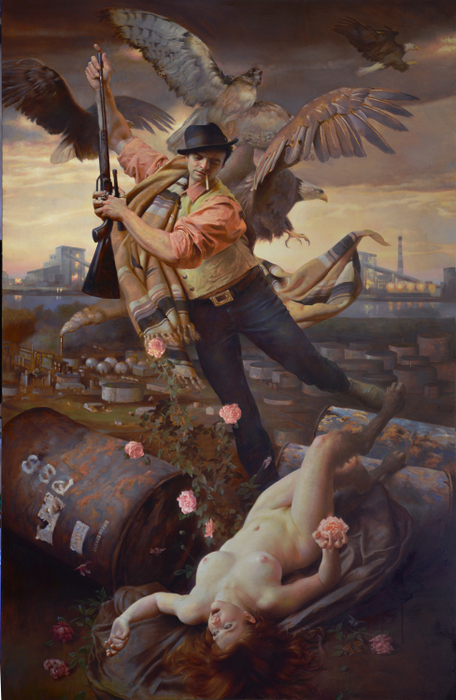
The Roses Never Bloomed So Red by Adam Miller, 2013
Similarly, Miller’s (2013) work The Roses Never Bloomed So Red employs the traditional composition of paintings that depicted the defeat of Satan by the archangel Michael. In Miller’s adaption a hunter takes the place of Michael, a satyress that of the devil’s. But the contemporary substitution is disturbing. The ‘savage’ fauness is vanquished by the violent angel of ‘development’, and yet the bleakness of the ‘developed’ landscape they foreground compels us to see this victory as a great spiritual defeat. The traditional religious narrative is thus literally inverted, and again we find our ‘religious’ sympathies lying with the untamed and natural.
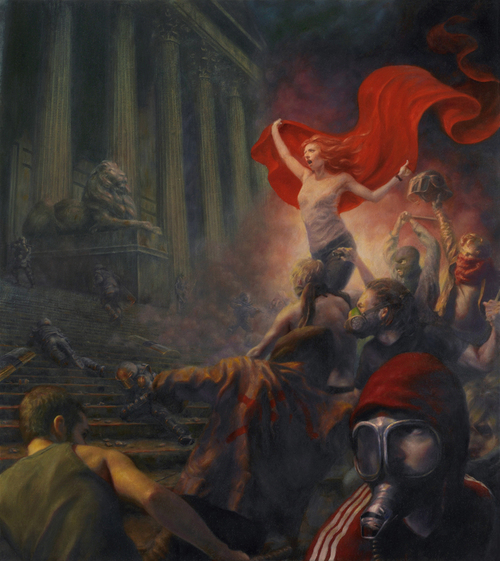
Rise by Billy Norrby, 2012
In a related way, Billy Norrby’s use of the mythic in his (2012) work Rise elevates the early twenty-first century rebellions — such as Occupy, the Greek protests against austerity, or even the ‘Arab Spring’ — to the level of the heroic and the ideal. The painting reads as a kind of updated “La Liberté guidant le people”, its red-haired rebel as potent a symbol as Delacroix’s own heroine. For all these artists, symbol and the rigors of traditional craft become strategies of aesthetic rebuke and rebellion against postmodern kitsch and commodity, offering in their stead a demonstration of metamodern neo-Romanticism.
One direction, then, that metamodern art is taking in its fraught desire for sense and depth is a willful assumption of constraints to counter postmodernism’s total emancipation from transcendent paradigms. These artistic constraints, like the myths they tell, are admittedly as artificial as they are useful. Indeed, if postmodernism was characterized by “contrived depthlessness” as Fredric Jameson asserts (13) perhaps metamodernism reflects a contrived depth.
REFERENCES
(1) Friedrich Nietzsche, The Gay Science, trans. Walter Kaufmann (New York: Vintage, 1974), 181.
(2) Jean-François Lyotard, The Postmodern Condition: A Report on Knowledge, trans. Geoff Bennington and Brian Massumi, Theory and History of Literature, Vol. 10 (Minneapolis: University of Minnesota Press, 1984), xxiv.
(3) In a recent conversation with philosopher John Hare, I was told the dichotomy comes to the fore as early as Patristic theology. The basic paradigm, in any event, can be traced from medieval scholasticism, through Kant, Hegel, and beyond.
(4) Jean Baudrillard, Simulacra and Simulation, The Body, In Theory: Histories of Cultural Materialism, trans. Sheila Faria Glaser (Ann Arbor: University of Michigan Press, 1995).
(5) David Harvey, The Condition of Postmodernity: An Enquiry into the Origins of Cultural Change (Cambridge: Blackwell, 1989), 10.
(6) Ibid., 44
(7) Fredric Jameson, Postmodernism, or, the Cultural Logic of Late Capitalism, Post-Contemporary Interventions (Durham: Duke University Press, 1991), 12.
(8) Timotheus Vermeulen and Robin van den Akker, “Notes on Metamodernism,” Journal of Aesthetics and Culture 2, 2010.
(9) Timotheus Vermeulen and Robin van den Akker, “Metamodernism: A Brief Introduction”, 2015, http://www.metamodernism.com/2015/01/12/metamodernism-a-brief-introduction/.
(10) Timotheus Vermeulen and Robin van den Akker, “What Is Metamodernism?”, Notes on Metamodernism, 2010, http://www.metamodernism.com/2010/07/15/what-is-metamodernism/.
(11) Ibid.
(12) Brandon Kralik, “The Post Contemporary Paradigm,” 2014, http://www.huffingtonpost.com/brandon-kralik/the-post-contemporary-par_b_5731594.html
(13) As quoted in David Harvey, The Condition of Postmodernity: An Enquiry into the Origins of Cultural Change (Cambridge: Blackwell, 1989), 58.
Images
Second image: Balloon Dog Sculpture by Ian Young on Flickr, Creative Commons
Third image: Pieta by Martin Wittfooth, 2011
Fourth image: The Roses Never Bloomed So Red by Adam Miller, 2013
Fifth image: Rise by Billy Norrby, 2012

So the new religion of this age is post-atheist; we make ourselves gods (transhumanism, cyborgs) and create our own (artificial super intelligence), building and eventually believing in the myths we create.
The emphasis on both ‘reconstruction’ and ‘mythopoeia’ in the metamodern aesthetic reminds me of both John Dewey’s philosophy of ‘reconstruction’ and Joseph Campbell’s analysis of ‘creative mythologies’—both which emphasized recreating a common human experience that both acknowledges and transcends cultural contingencies.
Dewey shared what we may call postmodern skepticism but called for pragmatic ‘reconstruction’ (in contrast to postmodern ‘deconstruction’ a la Derrida)—in this way, as Larry Hickman observes, Dewey and the Pragmatists were ahead of their time by laying the groundwork for post-postmodernism (see Hickman’s Pragmatism as Post-Postmodernism).
Likewise, Campbell—echoing Nietzsche in recapping the death of old religious authority as we entered the technological age—talked about the importance of mythopoetic artists like James Joyce. Using contemporary metaphors, these artists recreate archetypal motifs in human experience, especially feelings of transcendence (what Campbell called the ‘metaphysical function’ of mythology: the transcendent opening up to cosmic awe—see his Primitive Mythology and Creative Mythology).
The metamodern aesthetic seems to brilliantly renew these important precursors to post-postmodernism with neo-romantic depth, sublimity, dimensionality. If I understand this article correctly, I especially appreciate how the author highlights the ambiguity of neither decidedly affirming nor outright rejecting grand narratives, which allows for the possibility of transcendent experience.
Writing a paper on the mythopoetics of David Bowie and Kanye West and this idea of transcendent immanence is exactly what I see in their pop music. the characterization of the Dionysian, self-destructive God which is all we’re left with after ‘the Death of God’. Cool stuff, good read.
Excellent read, as usual…. I must find a way to subscribe to this network. This reading on the return of the myth has made me think of the Myths color field paintings by Papagoda and the use of story \ analogy as depth…
So metamodern is “back to canvas and twist it once around”? You can get the real metamodern if you will able to understand western society: its beginning, western rationalism and its PR in context with the rest of the world, before and after first and second wave of colonization and modern wars and coups. Norrby’s picture Rise should be concern with the beginning of royal blood of old and modern eite and mechanism behind this nonsense. Delacroix didn’t have Internet. You cannot reconstruct if you don’t know the reasons behind wrong construction. Metamodernists owe this to the precariat.
Forgive me if I say that “contrived depth” doesn’t sound very satisfying. How about the real thing, as in Plato, Meister Eckhart, William Blake, Walt Whitman, or Virginia Woolf? Can anyone live without the “grand narrative” of personal liberation or the hero’s journey? Perpetual (“post”-this and “post”-that) avant-gardist skepticism suffocates itself. When Gorgias said there was no truth, his sole claim to our attention was that he was articulating something that could in fact be true.